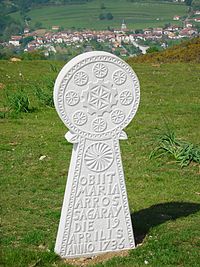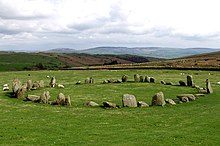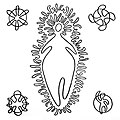أساطير باسكية
المظهر

الأساطير الباسكية (بالإنجليزية: Basque mythology) لم تنج أساطير الباسكيين القدماء، عامة، بسبب وصول المسيحية إلى بلاد الباسك بين القرنين الرابع والثاني عشر الميلاديين. يعتمد معظم ما يُعرف عن عناصر نظام المعتقد الأصلي هذا على تحليل الأساطير ودراسة أسماء الأماكن والمراجع التاريخية الشحيحة للطقوس الوثنية التي يمارسها الباسكيون.[1]
الآلهة
[عدل]- أيد: إلهة صغيرة للرياح والهواء.
- أمالور [الإنجليزية]: إلهة الأرض.[2]
- إيْت [الإنجليزية]: إله العواصف، يرتبط أحيانًا بالنار والجليد.[3][4]
- إيغوي [الإنجليزية]: إله رياح ثانوي، مرتبط بالرياح الجنوبية.
- إكي [الإنجليزية]: إلهة الشمس، ابنة أملور.[5]
- إيلارغي [الإنجليزية]: إلهة القمر، وهي أيضًا ابنة أملور.
- إنغوما [الإنجليزية]: إله الأحلام والكوابيس الخبيث.[6]
- ماري: إلهة أم، وزوجة الإله سوغار.[7]
- أوركو [الإنجليزية]: إله الرعد.[8]
- سوغار [الإنجليزية] أو شوقار: إله العواصف والرعد، وزوج ماري. عادة ما يتم تخيله على أنه تنين أو ثعبان.[9]
- آيرايتشوك [الإنجليزية]: عفاريت باسكية، والتي يمكن أن تكون مفيدة أو مؤذية اعتمادًا على مدى حسن معاملتهم.
أرواح وكائنات أخرى
[عدل]
- أيتكسي: روح تعيش في الكهوف يتخذ شكل ثور أحمر صغير، ولكن كونه متغير الشكل، يأخذ في بعض الأحيان شكل رجل.[10][11]
- آكربلتز [الإنجليزية]: روح شيطانية على شكل الماعز بيلي.
- باساغون: يلقب سيد أو رب الغابة.[12] هو رجل الغابة المتوحش.
- غايزكين [الإنجليزية]: روح شريرة تُسبب المرض.[13]
- غاويكو [الإنجليزية]: روح شريرة تخرج في الليل.[14]
- هيرنشوغ [الإنجليزية]: التنين الذي يلعب دورًا مهمًا في بعض الأساطير. غالبًا ما يظهر هيرنشوغ في شكل ثعبان.[15]
- جون الدب [الإنجليزية]: هو بطل نصفه إنسان ونصفه دب.[16]
- جنتيل [الإنجليزية]: هو جنس من العمالقة. يصور العمالقة أحيانًا وهم يرمون الحجارة على الكنائس.
- لامياك: حوريات بأقدام طيور تسكن في الأنهار والينابيع.[17]
- مايرو [الإنجليزية]: جنس من العمالقة الذين يبنون دوائر حجرية.
- أوديي [الإنجليزية]: روح الطبيعة المرتبطة بالرعد والتجسيد للجو العاصف أو الغيوم.[18]
- أولنتزرو [الإنجليزية]: أحد عمالقة الجنتيل، وهو المناظر لسانتا كلوز.
- القديس مارتن الصغير [الإنجليزية]: شخصية المحتال المسيحي الشعبية. سرق أسرار الزراعة والبذر والحصاد من الباسغون (أسياد الغابة).
- سورجينك: هُنَّ خادمات ومساعدي الإلهة ماري. إنه أيضًا اسم باسكي للسحرة أو الكاهنات الوثنيين.
- تارتالو [الإنجليزية]: هو النظير الباسكي لصقلوب اليوناني.[19]
معرض صور
[عدل]-
الإلهة أمالور
-
الإلهة ماري
-
تمثيل حديث للإله سوغار بوصفه ثعبانا أو تنينًا
-
لوحة سبت الساحرات، ويظهر الماعز بيلي الشيطاني
-
تصوير فني لباساغون ورفيقته الباساندير.
-
تخيل فني لجون الدب
-
أحد عمالقة الجنتيل
-
نحت لأحد الحوريات لامياك
-
مجسم لتارتالو
-
دمية لأولنتزرو
المراجع
[عدل]- ^ "The Basque Mythology at the present time" (PDF). KOBIE (Serie Antropología Cultural). Bilbao. Bizkaiko Foru Aldundia-Diputación Foral de Bizkaia. مؤرشف من الأصل (PDF) في 2020-11-25. اطلع عليه بتاريخ 2020-03-07.
- ^ Ortiz-Osés, Andrés (1985). Antropología simbólica vasca (بالإسبانية). Anthropos Editorial. ISBN:9788485887842. Archived from the original on 2021-08-30.
- ^ Lurker، Manfred (1987). Dictionary of gods and goddesses, devils and demons. روتليدج. ص. 104. ISBN:978-0-7102-0877-4.
- ^ Eliade، Mircea؛ Charles J. Adams (1987). The Encyclopedia of religion, Volume 2. مكملين ناشرون. ص. 81. ISBN:978-0-02-909710-6. مؤرشف من الأصل في 2021-12-23.
- ^ Michel Duvert, Dictionnaire illustré de mythologie basque [« Diccionario Ilustrado de Mitología Vasca y algunas de sus fuentes »], Donostia, Baiona, Elkarlanean, 1993, 372 p. [détail des éditions] ((ردمك 2903421358) et 9782903421359, OCLC 416178549)
- ^ Theresa Bane, Encyclopedia of Beasts and Monsters in Myth, Legend and Folklore, 2016
- ^ This derives from articles in the Enciclopedia General Ilustrada del Pais Vasco Encyclopedia Auñamendi, which in turn cite Euskalerriaren Yakintza, Tomo I "Costumbres y supersticiones", by folklorist Resurrección María de Azkue (1864-1951). It notes that additional legends were recorded by Jose Miguel Barandiaran and Juan Thalamas Labandibar.
- ^ Salyer، Kirsten (2 أكتوبر 2012). "Weather Channel Names Winter Storms; Watch Out for Orko!". Bloomberg Businessweek. مؤرشف من الأصل في 2014-09-26. اطلع عليه بتاريخ 2013-02-10.
- ^ Trask, L. The History of Basque, Routledge 1997 (ردمك 0-415-13116-2)
- ^ Rose، Carol (1998). "A". Spirits, Fairies, Leprechauns and Goblins. Norton. ص. 1. ISBN:0-393-31792-7.
- ^ Matthews، John & Caitlin (2005). The Element Encyclopedia of Magical Creatures. Harper Collins. ص. 5. ISBN:0-00-720873-1.
- ^ Lurker، Manfred (1987). The Routledge Dictionary of Gods and Goddesses, Devils and Demons. روتليدج. ص. 30. ISBN:0-415-34018-7. مؤرشف من الأصل في 2021-08-30.
- ^ Martín de Retana, José María (1972). La Gran enciclopedia vasca (بالإسبانية). Vol. 7. p. 417. Archived from the original on 2020-02-13.
- ^ J. M. Barandiaran, Diccionario de Mitología Vasca, Txertoa, Donostia, 1984
- ^ Lurker، Manfred (2 أغسطس 2004). The Routledge Dictionary of Gods and Goddesses, Devils and Demons. DOI:10.4324/9780203643518. ISBN:9780203643518.
- ^ Delarue (1949), pp. 318-320: analysis of themes for sections II ~ VII (applicable to Type 301 B)
- ^ Williams, Elena Arana (1989). Basque Legends in their Social Context. Basque Studies Program. ص. 119–120. ISBN:9781877802027. مؤرشف من الأصل في 2020-02-20. اطلع عليه بتاريخ 2012-07-12.
{{استشهاد بكتاب}}:|موقع=تُجوهل (مساعدة) - ^ Encyclopedia Auñamendi. "Basque Mythology: Odei". Buber's Basque Page. مؤرشف من الأصل في 2018-05-25. اطلع عليه بتاريخ 2010-10-04.
- ^ ikaskuntza، aunamendi.eusko. "Mythology". Auñamendi. مؤرشف من الأصل في 2020-08-12. اطلع عليه بتاريخ 2019-07-08.










